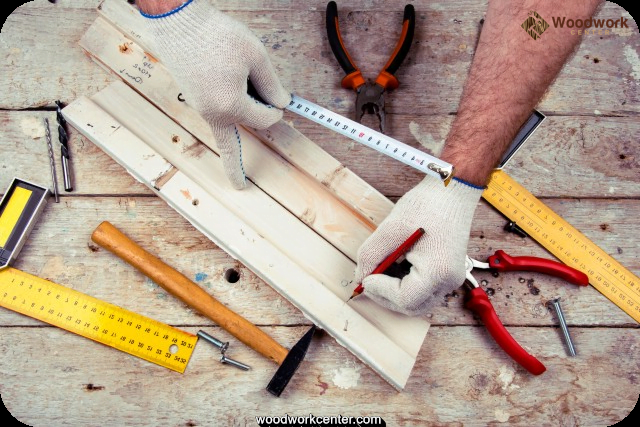Introduction to woodworking devices and their importance
Woodworking devices are tools that are used to shape and fashion wood. Throughout history, they have been a crucial part of the craft of carpentry, and over the centuries, various tools have been developed to improve both reliability and accuracy. Early woodworking devices included simple hand-powered drills, saws, planes, and chisels made from bronze and copper with iron and steel coming much later on.
Today’s modern customer can choose from a wide variety of high-quality corded or cordless power tools designed for a variety of needs and purposes. Major advancements such as computer-controlled router tables help to increase precision for carving intricate details. The range also extends to jigsaws, riveting guns and biscuit joinery devices that allow even the most complicated joinery operations to be tackled with relative ease. In addition, batteries have opened up a whole new world of portability for do-it-yourselfers who don’t want to be tied down to an electrical outlet.
From basic handheld devices all the way through to sophisticated machines loaded with electronic controls”woodworking devices increasingly reflect modern technology’s influence in their production. They are essential in helping craft workers create unique projects like furniture or cabinetry quickly while maintaining accuracy at the same time.
Types of woodworking devices and how they are used
Woodworking devices come in many different forms to suit the unique needs of any woodworker. The most common types of woodworking devices are hand tools, power tools, pneumatic tools and stationary machinery. Hand tools such as saws, chisels and planes are popular due to their cost-efficiency and versatility. They require a bit of skill, however they can be relatively inexpensive. Power tools such as grinders, routers and sanders are some of the most powerful tools on the market, offering much more precision than hand tools but generally being more expensive and requiring special safety precautions when operating. Pneumatic tools run on pressurized air rather than electricity and offer quicker results when compared to traditional power tools. Finally, stationary machinery like jointers, band saws and planers provide increased accuracy with certain cuts and joinery tasks are ideal for larger production workshops or small hobbyists who have access to dedicated workshop space. Across these four categories of woodworking devices there is a wide variety of prices, capabilities as well as innovative features that range from beginner level devices all the way up to high-end machines that include things like laser guidance, computerized speed settings or digital measuring readouts. By considering your specific requirements it is possible for any woodworker to find the perfect device for their trade.
Benefits of investing in woodworking devices
The financial benefits of investing in woodworking devices are numerous. It can significantly reduce the time needed to complete projects, saving money on labor costs. Additionally, by buying your own tools and materials you can often save money on the cost of hiring someone else to do your work. This is especially true for tasks that require expensive and specialized equipment. Woodworking devices can also be used to mass produce items, allowing you to sell larger numbers of products at a lower price point and potentially creating a profitable venture.
The environmental benefits of investing in woodworking devices cannot be overstated either. As most woodworking involves cutting down trees, we should take all precautions necessary to help protect forests and their native flora and fauna. By using more advanced tools and techniques, you can help minimize waste by optimizing usage out of each piece of wood that is cut down. Additionally, accuracy in the production process can lead to less costly methods such as using less glue in order to achieve a desired product or finish. Finally, investing in higher quality supplies from sustainable sources helps ensure that forests are being managed responsibly and our natural resources are never abused or depleted for personal gain.
Reviews of popular woodworking devices on the market
One of the most popular devices for woodworking is a table saw. With a table saw, more intricate designs and cuts can be created to make furniture, cabinetry, and other projects with precision. Table saws are ideal for cuts including dados, rabbets, and crosscuts on larger pieces of hardwoods. Examples of projects that can be created with a table saw include bookcases, bookshelves, chests of drawers, dining room tables, coffee tables, and cabinets.
Another popular woodworking device is a miter saw. A miter saw is most often used to create accurate angled and crosscuts on smaller pieces of wood. With the ability to cut angles up to 45 degrees in both directions, it’s ideal for making picture frames or wood trim work. Examples of projects that one could create using a miter saw include custom shelving units, crown molding installation on walls or ceilings, window frames and door casings.
Lathes are also commonly used by woodworkers for creating perfectly symmetrical curved objects such as columns or railings as well as solid furniture pieces like stools and legs for coffee tables. Lathes can also be used to carve out intricate details like decorative grooves into objects made from various materials ranging from softwood to hardwood or even metals like brass or copper. Examples of projects you can create with a lathe include tables legs with ornate details, turning bowls with curved edges from solid blocks of hardwood and creating spindles for chairs in various shapes and sizes.
Tips and tricks for using woodworking devices effectively
Safety Precautions when Working with Woodworking Devices
When starting any project with woodworking devices, safety should always be top priority. Be sure to read the safety instructions and guidelines included with your tools and follow them at all times. Make sure you wear appropriate protective gear when working, such as gloves, dust masks, protective eyewear, and clothing that won’t snag on your power tools or get in the way of their moving parts. Additionally, be sure that any electric tools are plugged into a ground fault circuit interrupter (GFCI) outlet for added protection against shock hazards. Never use a tool if its cord is damaged or otherwise not functioning properly.
Before turning any device on, be sure you are familiar with how it functions and what its controls do. Use the proper speeds for cutting different woods – avoid over-speeding a router or other high powered devices which can cause significant kickback and cause injury. Also pay attention to the feed rate of wood – pushing too hard against the blade can risk binding and kickback headaches so take it slow and steady in order to maintain quality cuts while preventing excessive strain on the device’s motor. Follow these tips to stay safe while enjoying your woodworking experience!
Common mistakes and how to avoid them when using woodworking devices
When it comes to woodworking, not following the proper instructions when using any device can lead to costly mistakes. Without reading and understanding the operating manual for every device and tool you’re going to use, mistakes could be made during the course of assembly or construction that would require time, money and energy to repair. This is why it’s incredibly important to read all of the literature that comes with a device before using it.
Be sure to understand the importance of properly fitting the tools and devices together in order to create a sound construction project. Different tools are designed in different ways and will require attention to detail when connecting them together. Also make sure you have all of the necessary safety equipment needed before beginning your project such as protective eyewear, gloves, ear protection etc., because these items reduce the chance of injury or harm during use. Furthermore, always unplug any power tools from their source before performing maintenance or routine cleanings. This simple step should never be overlooked! Finally, inspect each piece you’re using regularly for signs of wear or degradation so you can replace worn out pieces in a timely manner instead of waiting until they fail during operation.
Summary of the importance of woodworking devices for projects
Woodworking devices are very important and can be used to complete projects of all sizes. Everything from table saws, routers and scroll saws, to sanders and biscuit jointers all offer a unique set of capabilities that are especially necessary for completing woodworking projects. These tools make it easier to build cabinets, shelves, furniture, and even small toys. With their help, one can create items that simply weren’t possible without them.
Table saws provide an ideal way to cut larger pieces of wood in the most exact manner possible. They also provide a straight edge for other cutting activities when making joints such as dovetails or finger joints. Routers are useful for making slight groove cuts and for routing out decorative patterns as well as general shapes in wood. Scroll saws allow users to cut intricate curves through wood quite precisely. Sanders enable perfecting surfaces before they’re stained or finished; while biscuit jointers allow butt joints ” needed to hold two pieces of wood together at 90 degrees ” to be made with greater structural integrity than adding nails or screws alone can provide.
These tools enable professionals and hobbyists alike to craft just about anything they wish in woodwork. With practice, carpentry projects can look wonderful exactly as desired: finely crafted items that are strong and attractive at the same time. In short, appropriately chosen woodworking devices can help tackle many types of projects regardless if they are small or large in nature; giving users the freedom to create whatever their hearts desire.
Conclusion
For those passionate about woodworking and eager to level up their craft, there are a number of devices that can be used to further enhance their skills. From safety devices such as goggles and dust masks to specialized tools like saws and vises, these items help make the woodworking process easier and more efficient. With these devices, anyone can gain control of their projects, giving them an opportunity to make structural and craftsmanship improvements in an organized manner.
For those looking to further expand their knowledge on woodworking devices, it is highly recommended they consult informational videos or books. Popular resources include YouTube tutorial videos, online courses, webinars, articles, magazines, publications from local craftspeople and hobbyist stores. Exploring these resources is a great way for a beginner or even expert woodworker to better understand what tools are available and how they can benefit different kinds of projects. Additionally, many detailed diagrams or pictures of each tool can provide further information on how it looks and works in practice.

Hi everyone! I’m a woodworker and blogger, and this is my woodworking blog. In my blog, I share tips and tricks for woodworkers of all skill levels, as well as project ideas that you can try yourself.





